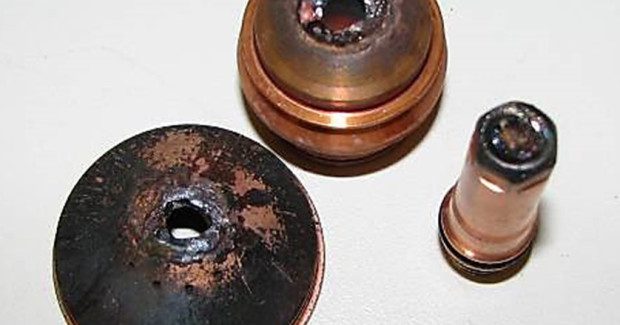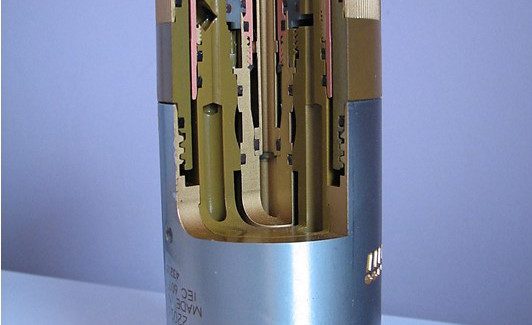Optimize the Use of Your Plasma Cutting Consumables
Often neglected in the push to get more parts of higher quality off the cutting table per shift are the very components that generate the high temperature plasma cutting arc. Up to 40 percent of the torch consumable parts that are typically scrapped can often be re-used with excellent cut quality.
Posted: May 4, 2015
Today, more than ever, the competitive fabricating shop spends a fair amount of effort improving shop floor efficiency. Whenever this involves a busy CNC plasma cutting operation, the focus is always on getting more parts of higher quality off the cutting table per shift. Behind the scenes, efforts often involve more efficient CAM nesting software, better material handling, the latest high definition class plasma cutters, easier to use CNC controls and much more.
Often neglected are the very components on this large, high technology machine that are generating the high temperature plasma cutting arc – the torch consumable parts.
In my travels over the last 30 plus years, the one constant that I always see on the cutting shop floor, next to every CNC plasma machine, is the 5 gal pail full of “used up” plasma cutting consumable parts. I’m sure this full pail of (mostly copper) spent consumables eventually finds its way to a recycling bin, but it has always been part of my job to reach into the bucket and pull out a handful of these parts for review. The erosion of the electrode, the swirl marks on the used nozzle and the condition of the nozzle and shield orifices tell a story about either the condition of the plasma system itself or of training issues that often should be addressed with machine operators. In many cases I find that as much as 40 percent of the parts in the scrap pail can go right back in the torch and be re-used with excellent cut quality.
While the total cutting cost per foot with a plasma cutter is the sum of the equipment cost, maintenance, material handling and labor, as well as gas and electrical usage and consumables, properly used consumables can account for less than 10 percent of the actual cutting cost (see Figure 1). Consequently, when not used to their full ability they can be much more of a burden on the actual cost of cutting.
https://youtu.be/wHAuq0ntUD4
For a perspective based on improvements in plasma cutting technology, the consumable cost portion per foot of cutting about 25 years ago amounted to about 25 percent or more of the total cutting cost, because consumables in older technology systems simply had to be replaced more often in order to maintain acceptable cut quality. While much of the improvement in consumable life, cut quality and operating cost of CNC plasma cutting equipment can be attributed to technology breakthroughs in system, power supply and torch designs, much of the responsibility of getting the most out of these consumable parts falls directly on the machine operator.
If the shop has no specific rules defining when to change consumable parts, then we should expect the operator to change all of the replaceable torch parts at the beginning of each shift. While some of the parts in the torch should be changed perhaps once per shift (depending on the power level, material thickness, amount of cutting etc.), other parts should last for 50 shifts or more.
The set of consumables from a Hypertherm HPR260XD shown in Figure 2 were removed from a system after cutting over 6,800 linear ft (about 1.3 miles!) of ½ in thick steel. Inspection procedures from the torch manufacturer show that these parts are only about half consumed, so they should be back in the torch to continue cutting for over a mile!
On the other hand, the consumables shown in Figure 3 were used in a shop environment where the supervisor instructed machine operators to use plasma cutting consumables until they fail. Unfortunately this method of “getting the most” out of your plasma cutting consumables causes a catastrophic failure of the consumables that usually destroys parts (such as the shield and nozzle) that may have lasted 2 times to 50 times longer than the electrode that failed. This type of usage can also cause torch damage, another expense added to the cost of cutting.
It is very important that machine operators understand the function of the individual torch consumable parts, how to read the wear patterns, and how to determine when the parts should be replaced or when they can be re-used. A substantial savings in consumable costs can be realized if these inspection procedures, available from the manufacturer of the plasma cutting system, are followed. I am aware of at least one large steel service center in the U.S. that reported an almost 40 percent reduction in consumable parts usage after intense training for all of their cutting machine operators in the terms of consumable parts inspection.
My suggestions for optimizing the consumable life in your CNC plasma cutting operation are:
- First, ensure you have the latest technology on your CNC machine. Advanced plasma system technology, CNC controls, height control systems and CAM software all work together to help provide the best combinations of cut quality, cut speed and consumable parts life.
- Ensure that your equipment is well maintained. These are complex cutting systems that will work well for decades if properly maintained. The major plasma manufacturers prescribe preventative maintenance programs that should be followed.
- Keep your operators up to speed on consumable parts optimization. Plasma cutter manufacturers offer some detailed documents that can be provided to guide your operators through consumable changes and will help them to better understand when an electrode or nozzle can be re-used, perhaps allowing for a few more miles of high quality cutting.




















